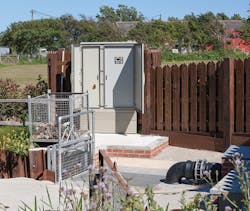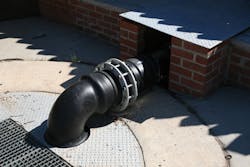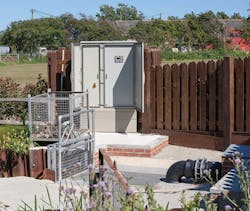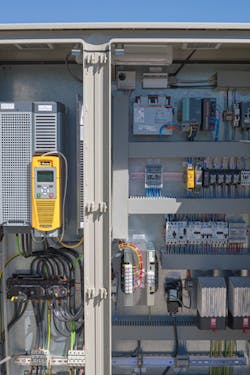Automated Pump Control
By Adam J. Moos
About 6 million Americans live in mobile home parks. Unless you are one of them or know one of them, you may not appreciate their vulnerability to the forces of nature until a disaster strikes. Vermont, for example, was devastated by Hurricane Irene a few years ago, and the aftermath inspired the Vermont Department of Housing & Community Development to finance a Report on the Viability and Disaster Resilience of Mobile Home Ownership and Parks. It cited a study by the University of Vermont (UVM) stating that nearly 12 percent of mobile homes in parks are located in flood hazard areas. Of the state’s 246 mobile home parks, 50 of them had at least one home located in a floodway.
So what to do? According to the report, very few plans from other states studied identified potential mitigation strategies. The few it mentions include tie-downs to minimize wind damage, creating new emergency access points, and water treatment systems. One mitigation strategy not mentioned in the study is something these flood-prone properties might benefit from: pumping.
U.K. Case in Point
A model for this solution comes out of the United Kingdom. In the U.K., trailer parks are called caravan parks, and flooding happens frequently at these sites. This problem was particularly devastating to the Warner Farm Touring Park, located on the south coast of England.
The Touring Park has three ponds on its property. Recent years had been particularly rainy, and during the course of those years the water in those ponds couldn’t subside fast enough, resulting in flooding.
Rather than close down its operations and relocate residents, the management of the Touring Park decided to take remedial action before the next flood hit. That action took the form of an interconnected pumping system.
Warner Farms worked with Arun Electrical, a Parker Hannifin customer, to design a pumping system that involved interconnecting the ponds. As the water draining into the first pool reaches a certain level, it is then pumped into the second, then into the third, eventually returning the water to the sea.
This scenario depends on the workings of an interconnected and intelligent drive system to control the pumping process. Parker’s AC30 variable frequency drive is at the heart of the system.
The system controls water levels via an internal proportional integral derivative controller (PID). The PID is standard in that it can work with any pump, but it can be tuned to the specific needs of any application. For example, Warner set the desired water level for each of the ponds, ensuring that the set level would allow for efficient natural drainage. If the water rises above the pre-set levels, then the pump will work faster and if below, will work slower, to ensure that the water levels remain within the safe pre-set boundaries. The system can also be programmed to take into account seasonal variations in water levels allowing Warner to specify pre-set values for summer and winter.
Warner considered other potential solutions that entailed setting flow limit levels, but those wouldn’t have enabled the same flow control precision.
The Communication Chain
Although Ethernet is the standard communications protocol, AC30 can also “talk” via a wide range of optional communications modules, which can be added or removed as required. This gives Warner a real-time system overview that’s accessible by a handheld smart phone or tablet.
The drives can be programmed to send a series of SMS messages via a modem to the smartphones of maintenance personnel should certain predetermined events occur. Specific text messages will be sent when the drive initiates pumping. Other pre-determined triggers can include power failure, RCD trip (stating exactly what caused the trip), water level change or pump stall. This lets maintenance teams monitor the system and take immediate corrective action when required.
Efficiency and Reliability
Controlling the motor via a variable speed drive in this application also delivers benefits in terms of efficiency. The drive matches system demands by synchronizing the workload of the motor to the pumping requirements, keeping running costs to a minimum and reducing wasted energy. The drives are installed in outdoor-rated enclosures and the AC30 is coated to withstand harsh environments.
Success Breeds More Ideas
The inbuilt software and programmability negated the need for a PLC, which meant removing a potential single point of failure and reducing system cost and complexity.
“The functionality was exactly what was needed in this application,” said Dave Kemp of Arun Electrical. “The technical support team at Parker was able to listen to our requirements and support us in building our customized system.”
The Parker team found Arun’s input equally valuable to the solution. “[It] made it possible for the technical guys at the Parker division to help them install the drives, and for the software team to help them develop the programming for the drives to communicate with each other,” said Matt Dowd, marketing communications manager, Automation Group Europe. “The programming played a really important role. Each of the drives had to know when to start pumping and when to stop in collaboration with the other drives in the system.”
So far the system has protected Warner Farm from floodwaters that devastated so many people’s lives across the U.K. Due to its effectiveness, the team at the park identified other potential risk areas and have added more pumping stations to further safeguard their site. They also have the flexibility to interconnect fans or any other type of remediation equipment that can be controlled by a drive to work in concert for certain applications.
This is one of many AC30 projects implemented around the world, made possible by a combination of engineering innovation and cooperation. As a result, Parker has created a standard pump control macro to make it easier to duplicate this type of application for future projects.
About the Author: Adam J. Moos is product manager for variable speed drives for Parker Hannifin’s Electromechanical Division. He holds a BASc in engineering management from Miami University and an MBA from Boston College.



